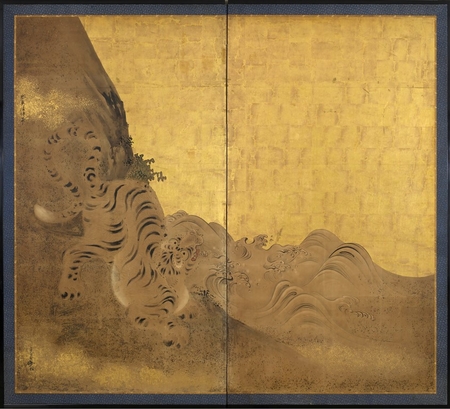Product Description
6958 A two-fold paper screen painted in ink on a buff and gold ground with a tiger crouching beneath a rocky outcrop on the seashore with cresting waves
Inscribed: Eishin Hōgen hitsu (painted by Eishin Hōgen)
Kojakuan kaō shō (authenticated by Kojakuan* with monogram)
Kano School, Japan 17th/18th century Edo period
Dimensions: H. 177cm x W. 195cm (69¾” x 77″)
Kanō Yasunobu (1613-1685). Familiar names: Genshirō, Shirojirō, Ukyōnoshin. Gō (art names): Bokushinsai, Eishin, Ryōfusai, Seikanshi. Yasunobu was the son of Kanō Takanobu, who died when Yasunobu was a child. He studied under Kanō Kōi and his elder brother Tan’yū. Yasunobu began working in Kyoto, then moved to Edo with Tan’yū, who founded the Kajibashi branch of the Kanō family. He became goyō eshi (official painter) to the shogun’s court, founding the Makabashi Kanō School. Yasunobu was later adopted by Kanō Sadanobu as his heir; hence also regarded as the eighth-generation head of the main Kyoto Kanō line. A connoisseur of paintings, Yasunobu signed many certificates of authentication for Kanō paintings. He was awarded the honorary title of Hōgen (lit. Eye of the Law) in 1662. One of his greatest accomplishments was painting the walls of the Shishinden Seiken of the Imperial Palace, Kyoto. He also painted landscapes, figures, kachōga (birds and flowers) and Buddhist subjects.
*Ōkura Kōsai (1795-1863). Gō (art name): Kojakuan. An art connoisseur and authenticator who served the Tokugawa Family in Kishu Province. In 1825 Ōkura Kōsai became a monk and took the art name Kojakuan. In 1851 he was granted the title of Hokkyō (lit. Bridge of the Law) the third highest honorary title bestowed upon Japanese Buddhist priests.
The Kano School was the largest and most influential painting school in Japanese history and it dominated the centre of the Japanese art scene from the middle of the Muromachi period (15th century) to the end of Edo period (19th century). The school worked closely with the ruling classes and the elite of Japanese society receiving countless commissions to paint the walls, sliding doors and screens of the palaces, castles and temples as well as smaller paintings such as hanging scrolls and fans.
Freely drawn representations of cresting waves, foam and sea spray are known as araumi (lit. rough sea) motifs. Following in the artistic traditions of T’ang China, such seas were initially portrayed with fearsome animals among the waves as depicted on this particular screen.
Tora (tiger), in Chinese thinking, is supreme among the land beasts and is sometimes depicted with the ideograph for the word ‘king’ on its forehead. Although viewed as dangerous, it is a symbol of strength, courage and longevity and is also accredited with the ability to fend off demons, ill-fortune and disease.
In the traditional cosmology of China, the tiger is one of the Four Sacred Creatures, representing autumn, the western direction, the wind and the colour white. It is thus the complement of the dragon, which represents the east, spring, and water. The interaction of the two, representing the play between wind and water, is thought vital for creating the nurturing weather that makes soil fertile and crops prosper.
Japan’s artistic treatment of tigers is usually highly stylised. With no indigenous specimens to study, artists of the pre-modern period constructed their notions of the tiger from skins imported into the country. This has resulted in a rather cat-like depiction of this noble feline beast.
n.b. Whilst painted by a member of the Kanō School this screen is probably not a work by Kanō Yasunobu.








